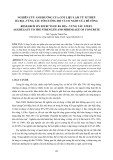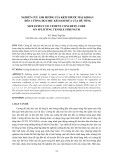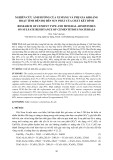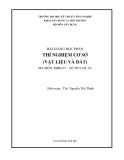
Tạp chí Khoa học Giao thông vận tải, Tập 75, Số 9 (12/2024), 2356-2370
2356
Transport and Communications Science Journal
EFFECT OF FLY ASH AND GROUND GRANULATED BLAST -
FURNACE SLAG ON STRENGTH OF HIGH PERFORMANCE
FINE GRAINED-CONCRETE
Ngo Duc Chinh*, Le Thanh Ha, Do Anh Tu
University of Transport and Communications, No 3 Cau Giay Street, Hanoi, Vietnam
ARTICLE INFO
TYPE: Research Article
Received: 13/08/2024
Revised: 22/11/2024
Accepted: 11/12/2024
Published online: 15/12/2024
https://doi.org/10.47869/tcsj.75.9.10
* Corresponding author
Email: chinhnd@utc.edu.vn; Tel: +84965810381
Abstract. The use of fly ash (FA) and ground granulated blast-furnace slag (GGBFS) as
partial replacements for cement in concrete is currently attracting significant attention from
both domestic and international scientists. This approach aims to address large volumes of
industrial waste sustainably. This paper presents the effects of FA and GGBFS on the
flexural and compressive strength of high-performance fine-grained concrete (HPFGC). In
this study, FA replaced 30% of the cement by weight, while GGBFS replaced cement in
amounts ranging from 15% to 45% by weight. The results indicate that FA and GGBFS
reduce the amount of superplasticizer needed and improve the workability of the concrete
mixture. It is possible to produce HPFGC with up to 75% of FA and GGBFS replacing
cement while achieving a compressive strength of up to 80 MPa. Increasing the FA and
GGBFS content in the placement of cement reduces the compressive strength of the
concrete at an early age of 3 days; however, at 7 days and especially at 28 days, the
compressive strength of HPFGC is equal to or higher than that of concrete using 100%
cement, depending on the amount of FA and GGBFS used. However, the flexural strength
of concrete with FA and GGBFS at 3 days, 7 days, and 28 days is consistently lower than
the flexural strength of the concrete using 100% cement.
Keywords: Fine grained-concrete, high performance, fly ash, ground granulated blast-
furnace slag, compressive strength, flexural strength.
@ 2024 University of Transport and Communications

Transport and Communications Science Journal, Vol 75, Issue 9 (12/2024), 2356-2370
2357
Tạp chí Khoa học Giao thông vận tải
ẢNH HƯỞNG CỦA TRO BAY VÀ XỈ LÒ CAO ĐẾN CƯỜNG ĐỘ
CỦA BÊ TÔNG HẠT NHỎ TÍNH NĂNG CAO
Ngô Đức Chinh*, Lê Thanh Hà, Đỗ Anh Tú
Trường Đại học Giao thông vận tải, Số 3 Cầu Giấy, Hà Nội, Việt Nam
THÔNG TIN BÀI BÁO
CHUYÊN MỤC: Công trình khoa học
Ngày nhận bài: 13/08/2024
Ngày nhận bài sửa: 22/11/2024
Ngày chấp nhận đăng: 11/12/2024
Ngày xuất bản Online: 15/12/2024
https://doi.org/10.47869/tcsj.75.9.10
* Tác giả liên hệ
Email: chinhnd@utc.edu.vn; Tel: +84965810381
Tóm tắt. Sử dụng tro bay (TB) và xỉ lò cao (XLC) thay thế một phần xi măng trong bê tông
hiện nay đang được sự quan tâm lớn của các nhà khoa học trong nước cũng như trên thế giới,
nhằm giải quyết lượng lớn phế thải công nghiệp này theo hướng phát triển bền vững. Bài báo
trình bày ảnh hưởng của TB và XLC đến cường độ chịu uốn và nén của bê tông hạt nhỏ tính
năng cao (BTHNTNC). Trong nghiên cứu này, TB được thay thế xi măng với hàm lượng 30%
theo khối lượng, XLC được thay thế xi măng từ 15-45% theo khối lượng. Kết quả cho thấy,
TB và XLC làm giảm lượng dùng phụ gia siêu dẻo và làm tăng tính công tác của hỗn hợp bê
tông; có thể chế tạo BTHNTNC với tổng lượng dùng TB và XLC lên tới 75% thay thế xi
măng và cường độ chịu nén đạt đến 80 MPa. Tăng hàm lượng TB và XLC thay thế xi măng
làm giảm cường độ chịu nén của bê tông ở tuổi sớm 3 ngày, nhưng ở 7 ngày và đặc biệt ở 28
ngày cường độ chịu nén của BTHNTNC bằng hoặc cao hơn bê tông sử dụng 100% xi măng
tùy theo lượng TB và XLC thay thế. Tuy nhiên, cường độ chịu uốn của bê tông sử dụng TB
và XLC ở 3 ngày, 7 ngày và 28 ngày nhỏ hơn cường độ chịu uốn của bê tông 100% xi măng.
Từ khóa: Bê tông hạt nhỏ, cường độ cao, tro bay, xỉ lò cao nghiền mịn, cường độ chịu nén,
cường độ chịu uốn.
@ 2024 Trường Đại học Giao thông vận tải
1. ĐẶT VẤN ĐỀ
Ngày nay, tro bay nhiệt điện và xỉ lò cao là hai trong số phế thải công nghiệp được thải ra
nhiều nhất trên thế giới cũng như ở nước ta. Tro bay là bụi khí thải dưới dạng hạt nhỏ thu
được từ quá trình đốt cháy nhiên liệu than đá trong các nhà máy nhiệt điện. Xỉ lò cao là phế
thải của ngành công nghiệp luyện quặng sắt thành gang. Theo quy hoạch phát triển ngành

Tạp chí Khoa học Giao thông vận tải, Tập 75, Số 9 (12/2024), 2356-2370
2358
điện nước ta đến năm 2030, nhiệt điện than vẫn chiếm tỷ trọng lớn đến 51,6%. Khoảng 200
triệu tấn than sẽ được dùng cho nhiệt điện và gần 40 triệu tấn tro xỉ sẽ thải ra môi trường [1].
Việc tận dụng phế thải tro xỉ không những làm giảm thiểu ô nhiễm môi trường, bảo vệ tài
nguyên thiên nhiên, tiết kiệm có hiệu quả nguồn tài nguyên thiên nhiên không tái tạo được mà
còn mang lại hiệu quả kinh tế bằng cách tạo nên các sản phẩm có giá trị và tiết kiệm được
diện tích đất lớn làm bãi chứa hoặc chôn lấp.
Các nghiên cứu về sử dụng riêng rẽ tro bay [2-7], xỉ lò cao nghiền mịn [8, 9] hay kết hợp
giữa hai loại phụ gia khoáng trên [10-14] cho bê tông đã được tiến hành ở Việt Nam và nhiều
nước trên thế giới. Một số nghiên cứu cho thấy, tro bay làm tăng tính công tác của hỗn hợp bê
tông hạt nhỏ, phù hợp với các hạng mục đòi hỏi bê tông có độ linh động cao [6]. Ngoài ra, tro
bay làm giảm cường độ của bê tông hạt nhỏ ở tuổi sớm (3, 7 ngày), cường độ chịu nén có thể
giảm từ 5-20%, cường độ chịu uốn giảm 4-16% khi hàm lượng TB thay thế xi măng từ 10-
30% ở 28 ngày [6]. Nghiên cứu khác cho thấy, có thể chế tạo bê tông sử dụng đến 60% tro
bay thay thế xi măng cho cường độ ở tuổi dài ngày (28 ngày hoặc hơn) cao hơn so với bê tông
đối chứng (BTĐC) [5]. Sử dụng 40% XLC thay thế xi măng có thể cho cường độ nén cao hơn
BTĐC đến 40% ở tuổi muộn (28 ngày hoặc hơn) và cường độ của bê tông giảm đi so với
BTĐC khi sử dụng 60%, 75% hoặc 90% XLC thay thế xi măng [8, 9].
Các nghiên cứu và thực tế sản xuất chỉ ra rằng, TB từ nhà máy nhiệt điện và XLC từ nhà
máy luyện gang thép là chất kết dính phụ thêm rất tốt có thể thay thế một phần hoặc hoàn toàn
xi măng và vật liệu gốc xi măng để chế tạo bê tông tính năng cao hạt nhỏ. Với tỷ lệ TB/XLC
dao động từ 20/80 đến 80/20, bê tông phát triển cường độ rất tốt, dao động từ 71,1 MPa đến
83,7 MPa [12]. Cường độ uốn của bê tông hạt nhỏ ở các độ tuổi sớm, đặc biệt là ở 3 ngày tuổi
thì XLC và TB làm giảm cường độ. Với hàm lượng TB không đổi là 20%, khi sử dụng XLC
với hàm lượng 15%-35%, cường độ của bê tông từ 7 ngày trở đi tăng nhẹ theo chiều hướng
gia tăng XLC và đạt cường độ cao nhất khi ở 35% XLC. Khi hàm lượng XLC lên đến 45%,
cường độ của bê tông giảm xuống đáng kể. Cụ thể, bê tông có hàm lượng 20% TB và 45%
XLC có cường độ uốn đạt 69,7% và 71,9% so với bê tông đối chứng tương ứng ở 3 và 7 ngày.
Tuy nhiên ở 28 và 56 ngày, cường độ của các loại bê tông chứa TB và XLC chỉ thấp hơn
không đáng kể so với bê tông đối chứng [13, 14].
Bài báo trình bày ảnh hưởng của TB và XLC đến lượng dùng phụ gia siêu dẻo, tính công
tác (độ chảy loang) cường độ chịu uốn và cường độ chịu nén của bê tông hạt nhỏ tính năng
cao (BTHNTNC). TB được thay thế xi măng với hàm lượng 30% theo khối lượng, XLC được
thay thế xi măng từ 15-45 % theo khối lượng.
2. VẬT LIỆU VÀ PHƯƠNG PHÁP NGHIÊN CỨU
2.1. Vật liệu chế tạo
Vật liệu sử dụng trong nghiên cứu gồm: xi măng Bút Sơn PC40, tro bay nhiệt điện Phả
Lại (TB), xỉ lò cao nghiền mịn Hòa Phát loại F (XLC) S95 xuất khẩu đảm bảo chất lượng theo
TCVN 11586:2016, cát mịn Móng Cái có kích thước hạt < 0,63 mm, cát thô sông Lô có kích
thước hạt < 5,0 mm (khối lượng riêng của cát là 2,65g/cm3), và phụ gia siêu dẻo của hãng
Sika (PGSD-3000 20M). Bảng 1 thể hiện thành phần hóa của xi măng, TB và XLC. Bảng 2 là
các chỉ tiêu cơ lý cơ bản của xi măng, TB và XLC. Hình 1 là phân bố kích thước hạt phân tích
lazer của xi măng PC40, TB, XLC; cát mịn và cát thô được xác định thành phần hạt theo
phương pháp sàng. Cấu trúc hạt của xi măng PC40, TB và XLC dưới kính hiển vi điện tử
(chụp tại Viện hàn Lâm Khoa học và Công nghệ Việt Nam) được trình bày trong Hình 2.

Transport and Communications Science Journal, Vol 75, Issue 9 (12/2024), 2356-2370
2359
Bảng 1. Thành phần hóa (%) của xi măng, TB và XLC.
Bảng 2. Chỉ tiêu cơ lý cơ bản của XM, TB và XLC.
Chỉ tiêu
Xi măng
Tro bay
Xỉ lò cao
Khối lượng riêng (g/cm3)
3,12
2,24
2,89
Kích thước hạt trung bình (µm)
14,12
16,42
7,87
Hình 1. Phân bố kích thước hạt của TB, XLC, xi măng PC40, cát mịn và cát thô.
Oxit
SiO2
Fe2O3
Al2O3
CaO
MgO
SO3
K2O
Na2O
MKN
Xi măng
21,29
3,30
5,72
63,18
1,10
1,50
0,30
0,12
0,20
TB
53,88
6,70
21,82
4,27
1,45
0,20
3,40
0,67
6,27
XLC
35,88
-
12,99
38,13
7,5
-
0,78
0,23
1,0

Tạp chí Khoa học Giao thông vận tải, Tập 75, Số 9 (12/2024), 2356-2370
2360
Hình 2. Cấu trúc hạt lần lượt của xi măng, TB và XLC dưới kính hiển vi điện tử SEM.
2.2. Thành phần cấp phối bê tông hạt nhỏ tính năng cao
Trong thiết kế thành phần cấp phối bê tông hạt nhỏ (BTHN) có tính công tác tốt (độ chảy
loang lớn (260-300mm)), thành phần hạt của hỗn hợp cốt liệu được tính theo lý thuyết độ lèn
chặt Funk and Dinger với q = 0,25 [15], theo phương trình sau:
(1)
Trong đó,
- P(D) là phần trăm khối lượng của cốt liệu lọt sàng kích thước Dmm;
- Dmin và Dmax lần lượt là kích thước hạt nhỏ nhất và lớn nhất trong hỗn hợp cốt liệu, mm.
Tỷ lệ phối hợp giữa các loại cốt liệu sẽ cho phân bố kích thước hạt của hỗn hợp cốt liệu
phù hợp với đường cong lý thuyết với độ lệch chuẩn nhỏ nhất. Trong nghiên cứu này, lý
thuyết độ lèn chặt Funk and Dinger được áp dụng với q = 0,25; Dmax = 5 mm and Dmin = 0,14
mm. Đường biểu diễn thành phần cấp phối hạt của hỗn hợp cốt liệu với các tỷ lệ cát mịn /cát
thô khác nhau được biểu diễn trong Hình 3.
Hình 3. Cấp phối hạt của cốt liệu.
Từ các kết quả thực nghiệm trên, có thể thấy rằng, tỷ lệ cát mịn/cát thô = 30/70 cho hỗn












![Bài giảng Quản lý vận hành và bảo trì công trình xây dựng [chuẩn nhất]](https://cdn.tailieu.vn/images/document/thumbnail/2025/20251006/agonars97/135x160/30881759736164.jpg)









![Ngân hàng câu hỏi trắc nghiệm Sức bền vật liệu 1: [Mô tả/Định tính Thêm để Tăng CTR]](https://cdn.tailieu.vn/images/document/thumbnail/2025/20250920/kimphuong1001/135x160/6851758357416.jpg)


![Trắc nghiệm Kinh tế xây dựng [chuẩn nhất]](https://cdn.tailieu.vn/images/document/thumbnail/2025/20250920/kimphuong1001/135x160/32781758338877.jpg)
